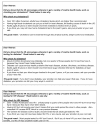Use of electronic personal health record systems to encourage HIV screening: an exploratory study of patient and provider perspectives
- PMID: 21843313
- PMCID: PMC3173346
- DOI: 10.1186/1756-0500-4-295
Use of electronic personal health record systems to encourage HIV screening: an exploratory study of patient and provider perspectives
Abstract
Background: When detected, HIV can be effectively treated with antiretroviral therapy. Nevertheless in the U.S. approximately 25% of those who are HIV-infected do not know it. Much remains unknown about how to increase HIV testing rates. New Internet outreach methods have the potential to increase disease awareness and screening among patients, especially as electronic personal health records (PHRs) become more widely available. In the US Department of Veterans' Affairs medical care system, 900,000 veterans have indicated an interest in receiving electronic health-related communications through the PHR. Therefore we sought to evaluate the optimal circumstances and conditions for outreach about HIV screening. In an exploratory, qualitative research study we examined patient and provider perceptions of Internet-based outreach to increase HIV screening among veterans who use the Veterans Health Administration (VHA) health care system.
Findings: We conducted two rounds of focus groups with veterans and healthcare providers at VHA medical centers. The study's first phase elicited general perceptions of an electronic outreach program to increase screening for HIV, diabetes, and high cholesterol. Using phase 1 results, outreach message texts were drafted and then presented to participants in the second phase. Analysis followed modified grounded theory.Patients and providers indicated that electronic outreach through a PHR would provide useful information and would motivate patients to be screened for HIV. Patients believed that electronic information would be more convenient and understandable than information provided verbally. Patients saw little difference between messages about HIV versus about diabetes and cholesterol. Providers, however, felt patients would disapprove of HIV-related messages due to stigma. Providers expected increased workload from the electronic outreach, and thus suggested adding primary care resources and devising methods to smooth the flow of patients getting screened. When provided a choice between unsecured emails versus PHRs as the delivery mechanism for disease screening messages, both patients and providers preferred PHRs.
Conclusions: There is considerable potential to use PHR systems for electronic outreach and social marketing to communicate to patients about, and increase rates of, disease screening, including for HIV. Planning for direct-to-patient communications through PHRs should include providers and address provider reservations, especially about workload increases.
Figures
Similar articles
-
Patient and provider perspectives of personal health record use: a multisite qualitative study in HIV care settings.Transl Behav Med. 2023 Jul 1;13(7):475-485. doi: 10.1093/tbm/ibac118. Transl Behav Med. 2023. PMID: 37084300
-
Patient Use of Electronic Prescription Refill and Secure Messaging and Its Association With Undetectable HIV Viral Load: A Retrospective Cohort Study.J Med Internet Res. 2017 Feb 15;19(2):e34. doi: 10.2196/jmir.6932. J Med Internet Res. 2017. PMID: 28202428 Free PMC article.
-
Uses of Personal Health Records for Communication Among Colorectal Cancer Survivors, Caregivers, and Providers: Interview and Observational Study in a Human-Computer Interaction Laboratory.JMIR Hum Factors. 2022 Jan 25;9(1):e16447. doi: 10.2196/16447. JMIR Hum Factors. 2022. PMID: 35076406 Free PMC article.
-
Utility, Value, and Benefits of Contemporary Personal Health Records: Integrative Review and Conceptual Synthesis.J Med Internet Res. 2021 Apr 29;23(4):e26877. doi: 10.2196/26877. J Med Internet Res. 2021. PMID: 33866308 Free PMC article. Review.
-
The health literacy demands of electronic personal health records (e-PHRs): An integrative review to inform future inclusive research.Patient Educ Couns. 2018 Jan;101(1):2-15. doi: 10.1016/j.pec.2017.07.010. Epub 2017 Jul 11. Patient Educ Couns. 2018. PMID: 28864052 Review.
Cited by
-
Underutilization of HIV Testing Among Men with Incarceration Histories.AIDS Behav. 2019 Apr;23(4):883-892. doi: 10.1007/s10461-018-02381-9. AIDS Behav. 2019. PMID: 30661215 Free PMC article.
-
Motivating, influencing, and persuading patients through personal health records: a scoping review.Perspect Health Inf Manag. 2012;9(Summer):1f. Epub 2012 Apr 1. Perspect Health Inf Manag. 2012. PMID: 22783154 Free PMC article.
-
Determinants of Consumer eHealth Information Seeking Behavior.AMIA Annu Symp Proc. 2015 Nov 5;2015:1121-9. eCollection 2015. AMIA Annu Symp Proc. 2015. PMID: 26958251 Free PMC article.
-
Acceptability of a Patient Portal (Opal) in HIV Clinical Care: A Feasibility Study.J Pers Med. 2021 Feb 16;11(2):134. doi: 10.3390/jpm11020134. J Pers Med. 2021. PMID: 33669439 Free PMC article.
-
Patient Portals and Patient Engagement: A State of the Science Review.J Med Internet Res. 2015 Jun 23;17(6):e148. doi: 10.2196/jmir.4255. J Med Internet Res. 2015. PMID: 26104044 Free PMC article. Review.
References
-
- Palella FJ Jr, Deloria-Knoll M, Chmiel JS, Moorman AC, Wood KC, Greenberg AE, Holmberg SD. Survival benefit of initiating antiretroviral therapy in HIV-infected persons in different CD4+ cell strata. Ann Intern Med. 2003;138(8):620–626. - PubMed
-
- Centers for Disease Control and Prevention. Late HIV testing - 34 states, 1996-2005. MMWR Morb Mortal Wkly Rep. 2009;58(24):661–665. - PubMed
-
- Anonymous. Screening for HIV: recommendation statement. Ann Intern Med. 2005;143(1):32–37. - PubMed
-
- Glynn M, Rhodes P. Estimated HIV prevalence in the United States at the end of 2003. Abstract: T1-B1101. Proceedings of the National HIV Prevention Conference. 2005.
LinkOut - more resources
Full Text Sources



